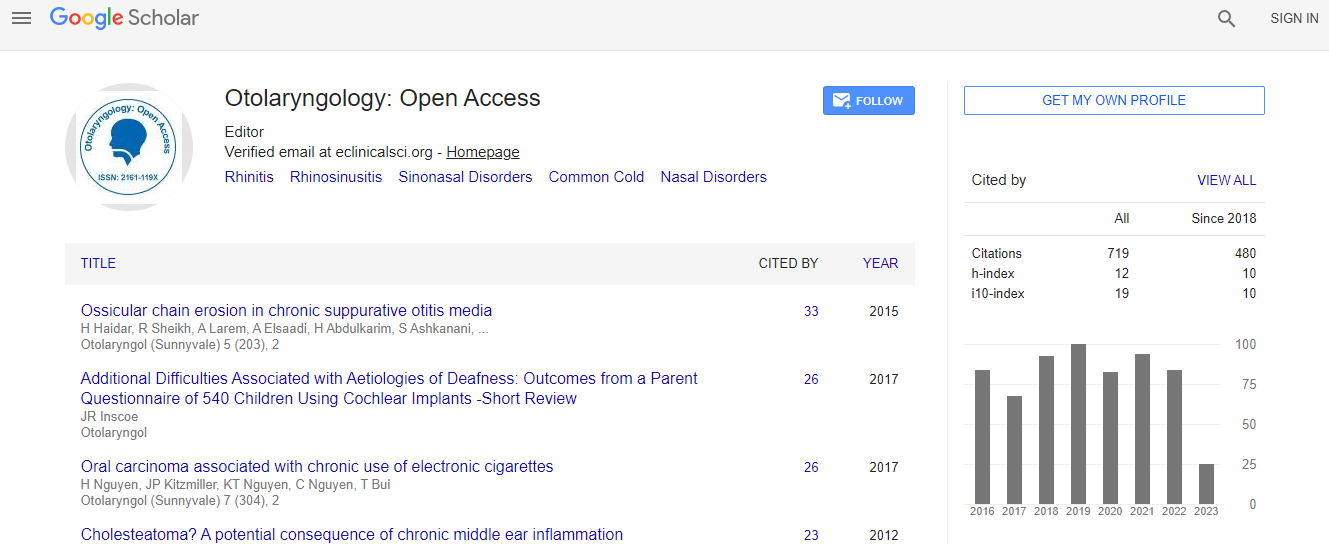Research Article
Otosclerosis Surgery: Contribution of Imaging in Surgical Failures and Labyrinthine Complications Diagnosis
Myriam Jrad1*, Asma Ben Mabrouk1, Aymen Ben Othmen1, Jihene Marrakchi2, Anis Zaidi1, Rym Zainine2, Ghazi Besbes2 and Habiba Mizouni11Department of Radiology, La Rabta Hospital, Jabberi 1017, Tunis, Tunisia
2Department of ENT, La Rabta Hospital, Tunis, Tunisia
- Corresponding Author:
- Myriam Jrad, MD
Clinical Chief
Departement of Radiology
La Rabta Hospital, Jabberi 1017
Tunis, Tunisia
Tel: +216 98618235
Fax: 00 216 71 56 22 17
E-mail: myriamjrad@gmail.com
Received date: October 02, 2016; Accepted date: October 21, 2016; Published date: October 28, 2016
Citation: Jrad M, Mabrouk AB, Othmen AB, Marrakchi J, Zaidi A, et al. (2016) Oral Carcinoma, Hpv Infection, Arsenic Exposure-Their Correlation in West Bengal, India the Otosclerosis Surgery: Contribution of Imaging in Surgical Failures and Labyrinthine Complications Diagnosis. Otolaryngol (Sunnyvale) 6:271. doi:10.4172/2161-119X.1000271
Copyright: © 2016 Jrad M, et al. This is an open-access article distributed under the terms of the Creative Commons Attribution License, which permits unrestricted use, distribution, and reproduction in any medium, provided the original author and source are credited.
Abstract
Objective: The purpose of this study was to review the role of post-operative imaging and to illustrate with a rich iconography the main causes of surgical failures and post-operative complications of otosclerosis. Subjects and methods: This a retrospective study of 49 ears having otosclerosis and undergoing middle ear surgery. CT scan was performed in the postoperative assessment when post-operative complication or unsatisfactory surgical results were suggested. Results: Surgical failures were noticed in 28 ears (57%): Hearing loss was the most frequent symptom (89%).Tinnitus was found in 21 cases and vertigo in three cases. Audiometric exploration found 21 cases of conductive hearing loss, six cases of mixed type and one case was a sensorineural type. The causes of surgical failure were erosion of the long process of the incus in four cases, uncudo-mallear dislocation in one case, displacement of the prosthesis in five cases and fibrosis of the oval window in one case. Progression of otosclerosis was noticed in 13 cases. Labyrinthine complication was retained in 21 ears of our study. The causes of labyrinthine complication were intravestibular protrusion of the prosthesis (15 cases), intravestibular footplate dislocation (1 case), perilymphatic fistula (1 case), ossificans labyrinthitis (1 case), infectious labyrinthitis (1 case) and intravestibular granulation tissue (1 case). In one case, no abnormities was retained in CT and MRI Conclusion: After this study, to ensure maximum efficiency in the postoperative monitoring and the management of complications and post-operative failures, the clinician is required to take into account both the functional findings, results audiometric and radiological data.

 Spanish
Spanish  Chinese
Chinese  Russian
Russian  German
German  French
French  Japanese
Japanese  Portuguese
Portuguese  Hindi
Hindi 
